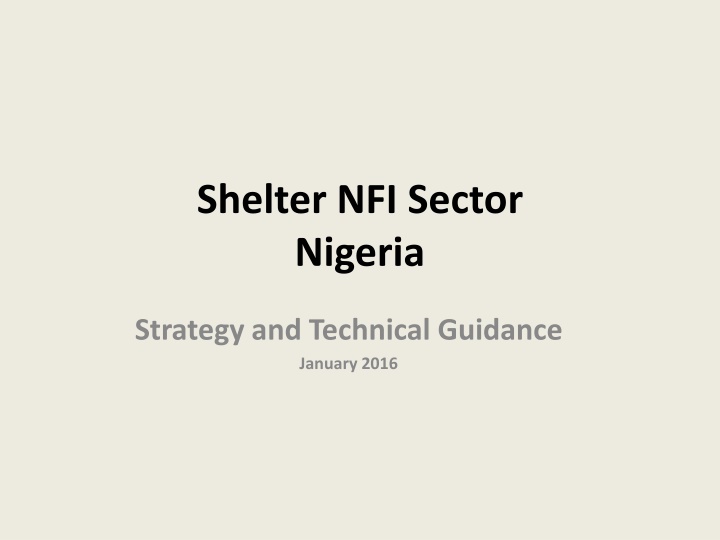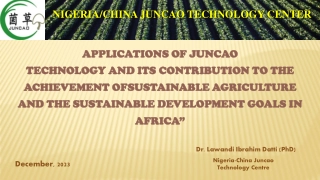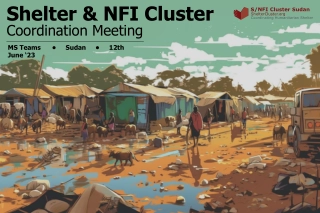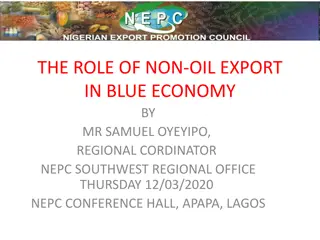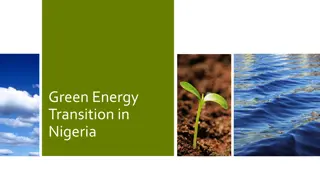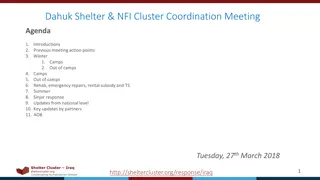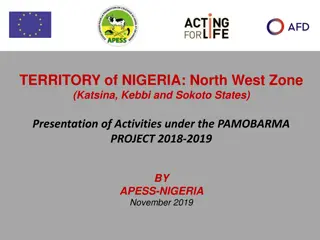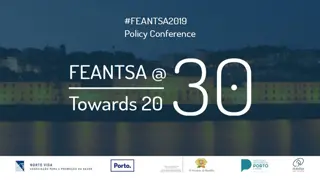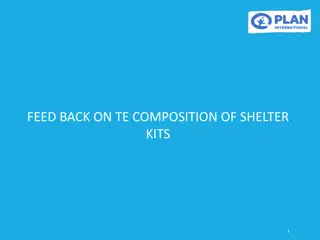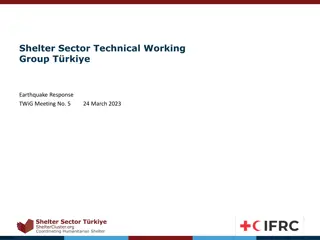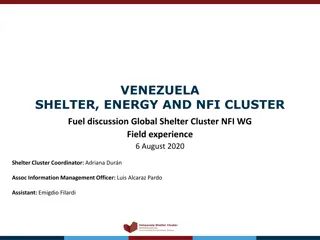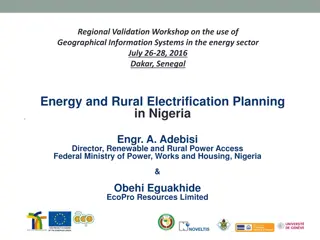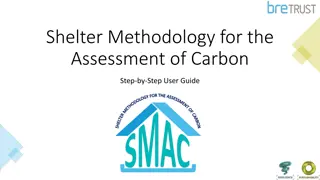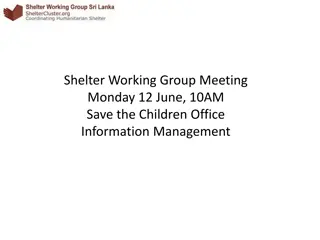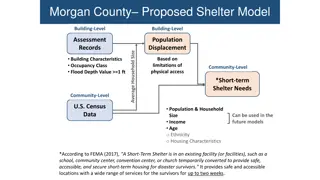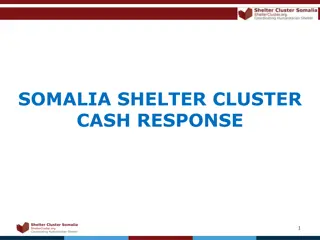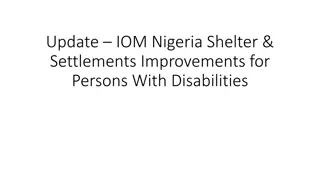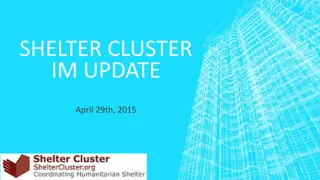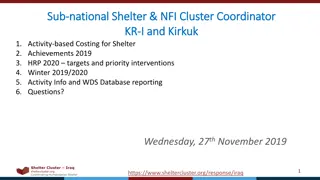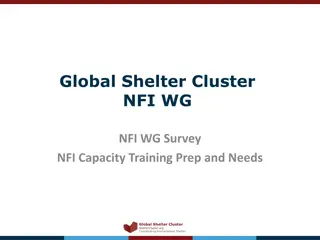Nigeria Shelter & NFI Sector Strategy
Providing shelter guidance & objectives for humanitarian response in Nigeria, ensuring efficient supply & delivery of emergency shelter kits to displaced communities. Sector strategies focus on harmonization, assessment, and targeted interventions to address specific needs.
Download Presentation

Please find below an Image/Link to download the presentation.
The content on the website is provided AS IS for your information and personal use only. It may not be sold, licensed, or shared on other websites without obtaining consent from the author.If you encounter any issues during the download, it is possible that the publisher has removed the file from their server.
You are allowed to download the files provided on this website for personal or commercial use, subject to the condition that they are used lawfully. All files are the property of their respective owners.
The content on the website is provided AS IS for your information and personal use only. It may not be sold, licensed, or shared on other websites without obtaining consent from the author.
E N D
Presentation Transcript
Shelter NFI Sector Nigeria Strategy and Technical Guidance January 2016
Sector strategy and guidance Harmonisation is beneficial: To make our response more predictable To ensure equity and conflict sensitive response To inform budgeting, fundraising and procurement To make consolidated procurement for cost and quality gains possible, if the sector chooses this To start informing levels of cash transfer for the sector Response should always should be based on assessment of specific needs, context and opportunities in each community Sector strategy and guidance are LIVING DOCUMENTS, to be revised as necessary
Shelter NFI Sector Objectives Humanitarian Response Plan 2016 OBJECTIVE 1: Ensure sufficient and flexible supply and targeted delivery of minimum standard emergency shelter and NFI kits (including assessment, distribution and post-distribution monitoring) to people in need, including displaced people in host communities. OBJECTIVE 2: Deliver reinforced emergency shelter to upgrade and decongest formal and informal camps to minimum standards. OBJECTIVE 3: Deliver locally appropriate shelter solutions for vulnerable IDPs in need in host communities, and returning to their communities of origin.
Group Targeting criteria SHELTER Estimate lifespan of intervention Estimate cost per HH (materials only, USD) EstimateHH, most vulnerablein need # Sector Target # Intervention Strategy: table beneficiary type, intervention, PiN, targets? Newly/secondarily displaced Fluid mobility, or land insecure According to need E-shelter kit =Cash/voucher 6 - 12 months 150.00 20,000 33,022 Transit Including cross-border According to need Communal shelter (1-5 days stay) 200.00 (ongoing use) 5,000 Living with hosts condition of shelter (overcrowding)/ vulnerability E-shelter (local) Shelter repair =Cash/voucher 6 12 months 150.00 Insecure land and access 119,000 3 5 years 450.00 Secure land and access 10,000 7,000 Formal and informal camps existing and planned, land secure condition of shelter/ vulnerability Reinforced e- shelter Shelter repair =Cash/voucher 450.00 16,000 8,000 Returnees to own land, in secure areas condition of shelter (destroyed)/ vulnerability Reinforced e- shelter Shelter repair =Cash/voucher 450.00 30,000 6,000 Durable Solutions: Linkage with ERWG and UNDAF
Group Targeting criteria NFI Intervention Estimate cost per HH (material only, USD) Estimatepeople in need # Sector Target # Newly/secondarily displaced According to need Non-Food Items kit =Cash/voucher 85.00 96,500 61,835 Transit According to need Living with hosts Most vulnerable in need Formal and informal camps Most vulnerable in need Returnees Most vulnerable in need
Maiduguri: decongestion and upgrade in formal and informal camps, and host communities
Kukurater informal camp, Damaturu: basic e-shelter (growth in informal camps in Yobe and elsewhere DTM Round VI)
Response in host communities Host community situation Response Living in the homes of others -Reinforced e-shelter construction within family compounds (where land/tenure is secure and displacement likely prolonged) -Shelter repair within family compounds Makeshift shelter on open land (usually privately owned) -Reinforced e-shelter construction (where land/tenure is secure and displacement likely prolonged) -Basic e-shelter kit (where land is insecure, or movement anticipated) Unfinished buildings (usually privately owned) -Shelter repair (where land/tenure is secure, and displacement likely prolonged) Renters ? As the sector moves shelter response into host communities, we need: Harmonised approach to tenure and materials ownership negotiations with landowners Agreement on how to define and allocate areas for partners to work (ward, or smaller designation?), and on approach to assessment/targeting (defining density, shelter condition, vulnerability) Further assessment of extent and needs of renters
Key considerations Urban vs rural: shelter response must be appropriate; State variations: Adamawa focus on host community and returns; Borno focus on decongestion and upgrade of camps and host community in Maiduguri; Yobe focus on upgrade in informal camps (which have been expanding in the last weeks); Secondary displacements/sudden influx - continued fluidity of movement - will remain a possibility the sector needs to retain ability for light and fast response at scale; Unseen need (inaccessible areas) large portions of Borno remain unseen the sector needs to engage in discussions around access, and retain ability for light and fast response at scale.
NFI kit content Minimum kit should be life-saving; appropriate to context; consider practicality (cost and scale) Items selected for distribution must be based on assessment findings SEMA (Adamawa flood) Proposed Quantity per HH Mercy Corps Items IOM IMC IRC SCI ACF 1 Cooking pot 7L 1 1 1 Cooking pot 5L 1 1 4 Plates 5 2 6 6 Kitchen set 4 Cup 5 2 6 6 4 Table Spoon 5 4 6 6 1 Kitchen knife 1 0 1 Service Spoon 1 1 1 Matress 3 1 2 Synthetic Sleeping Mats 3 1 1 2 2 2 3 Sleeping Blankets 3 1 1 2 4 3 Mosquito nets 2 2 3 3 Solar lights/flashlight?
SEMA (Adamawa flood) Proposed Quantity per HH Mercy Corps Items IOM IMC IRC SCI ACF 1 20L Jerrican 2 2 1 1 2 2 10L Jerrican 1 2 1 20L Bucket 2 1 2 10L Bowl 1 1 Kettle for hand washing 1 1 1 Water and hygiene 7 Laundry soap (bars) 7 4 10 3 7 Bathing Soap (250gms) 7 4 10 7 7 Absorbent cloth for sanitary purpose (1x2m) reusable 1 1 0 2 1 Aquatabs water purifier (sackets) 250 0 105 Clothing Length of cloth/kanga? Packing box sack 1
Respondents stated they would have found mattresses, clothes, medicine, cash and food more useful. - ACF, Post-Distribution Monitoring Report, Yobe, September 2015
Basic Emergency Shelter - For use when land use or access is insecure, and/or movement likely to remain fluid Distributions of basic material kits (plastic sheets, rope, poles) and tools to provide essential protection from the elements Basic emergency shelter will remain the core element of the emergency shelter response, considering scale, cost and access Items selected for distribution must be based on assessment findings - - - Shelter Repair - For use in host communities, where shelter is inadequate. Items specific to shelter repair needs to be based on detailed assessment. Technical support to be provided.
Proposed quantity per HH Items IOM ACF 2 2 2 Plastic sheet (size 4mx5m), 4kg 1 1 1 Rope (10mm with 20 meter long) 1 1 Tie/Galvanized Wire (1.5mm diameter, 25m long) Umbrella nails (75x3.6mm, head diameter 20mm, thickness 2mm) 1 1 Iron Nails no.2 (kg) 1 Iron Nails no.3 (kg) Shovels (round pt with Y handle presses carbon steel) Claw hammer (high carbon steel head with claw and flat side) Craw bar (one and half inch diameter with chisel end) 1 1 1 1 1 1 1 Handsaw (18 20 ) 1 PVC pail No. 12 6 6 Lumber poles
Reinforced Emergency Shelter Formal and informal camps and host communities - In camps and host communities, where land use is secure, and displacement in-situ is likely to continue - To include construction/technical support as well as materials - Up-front investment in decongestion and upgrade creating savings down the line - Rural and urban variations - People-centred design; climate considerations - Rural designs must be based on local materials and production as far as possible - Community participation/contribution to be sought wherever possible - Target severe overcrowding and inadequate shelter condition Return - - In return settings, on land owned by beneficiary Must take into account cultural factors: use of separate shelters for zauri and sleeping rooms, so that materials provided form the basis for recovery Target destroyed homes -
URBAN Reinforced Emergency Shelter Example: Maiduguri Working Group, Bakassi design
Unit cost (NGN) Total cost (NGN) Total cost (USD) Specification Unit Quantity Timber 4 x2 x12 hard wood (iron wood) Pcs 72 520 37,440 187 Timber 2 x2 x12 hard wood (iron wood) Pcs 20 350 7,000 35 Timber 1 x4 x12 hard wood (iron wood) Pcs 8 500 4,000 20 CGI ( Zinc) Roofing - 3 x10 Pcs 18 750 13,500 68 GI sheet 1 x10 Pcs 3 600 1,800 9 Straw under CGIs Pcs 0 0 0 0 mosquito net m2 11 350 3,955 20 4" nail kg 10 230 2,300 12 3" nail kg 3 230 690 3 2" nail kg 1 230 230 1 Roofing nail, in 7kg pack Pack 2 1,500 3,000 15 4" hinges for doors and windows Pcs 10 200 2,000 10 Reinforced tarpauline 4x5m Pcs 5 6,000 30,000 150 Total materials 105,915 530 Labour (20%) 21183 105.915 Total shelter cost for 1 family 8 persons 127,098 635
Specifications Guidance: IOM, IFRC global specifications Local procurement versus quality? (plastic sheeting; CGI) Local procurement versus market impact? (regional market assessment planned for January) Consolidated procurement for cost effectiveness?
Information Management Tool Frequency Responsible Format Purpose Response reporting (assessment, PDM reports) Ad hoc, as response is delivered Delivering agency Agency specific Tracking coverage and approach, sharing lessons learned E-Shelter NFI distribution report Monthly Delivering agency Sector format Tracking sector delivery and plans CCCM Multi- sector report Weekly Designated CCCM agency for site Sector format
